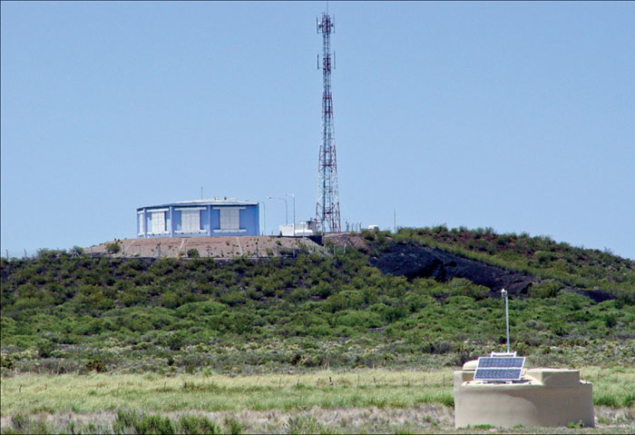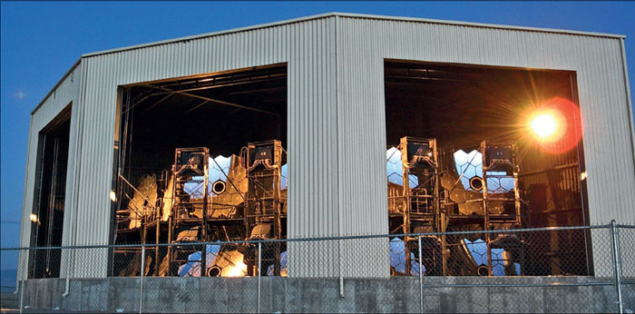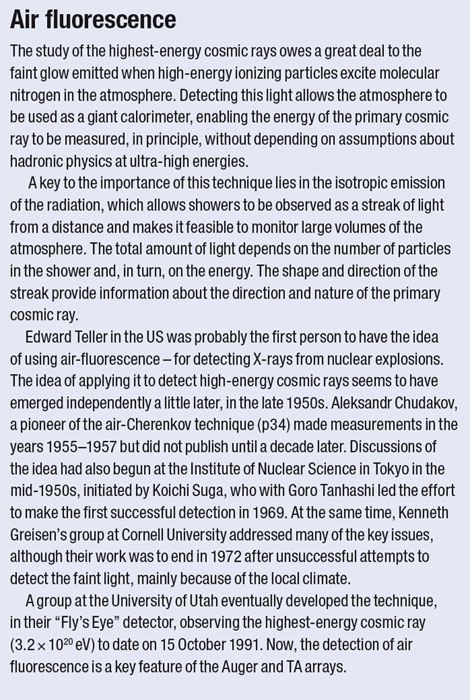A symposium at CERN discussed the challenges in detecting extreme events.

“Analysis of a cosmic-ray air shower recorded at the MIT Volcano Ranch station in February 1962 indicates that the total number of particles in the shower was 5 × 1010. The total energy of the primary particle that produced the shower was 1.0 × 1020 eV.” Thus begins the 1963 paper in which John Linsley described the first detection of a cosmic ray with a surprisingly high energy. Such ultra-high-energy cosmic rays (UHECRs), which arrive at Earth at rates of less than 1 km–2 a century, have since proved challenging both experimentally and theoretically. The International Symposium on Future Directions in UHECR Physics, which took place at CERN on 13–16 February, aimed to discuss these challenges and look to the next step in terms of a future large-scale detector. Originally planned as a meeting of about 100 experts from the particle- and astroparticle-physics communities, the symposium ended up attracting more than 230 participants from 24 countries, reflecting the strong interest in the current and future prospects for cosmic rays at the highest energies.
Soon after Linsley’s discovery, UHECRs became even more baffling when Arno Penzias and Robert Wilson discovered the cosmic microwave background (CMB) radiation in 1965. The reason for this is twofold: first, astrophysical sources delivering particle energies of 10 to 100 million times the beam energy of the LHC are hard to conceive of; and, second, the universe becomes opaque for protons and nuclei at energies above 5 × 1019 eV because of their interaction with the CMB radiation. In 1966, Kenneth Greisen, and independently Georgy Zatsepin and Vadim Kuz’min, pointed out that protons would suffer pion photoproduction and nuclei photodisintegration in the CMB. These processes limit the cosmic-ray horizon above the so-called “GZK” threshold to less than about 100 Mpc, resulting in strongly suppressed fluxes of protons and nuclei from distant sources.
The HiRes, Pierre Auger and Telescope Array (TA) collaborations recently reported a suppression of just this type at about the expected threshold. Does this mark the long awaited discovery of the GZK effect? At the symposium, not all participants were convinced because the break in the energy spectrum could also be caused by the sources running out of steam. To shed more light on this most important question of astroparticle physics, information about the mass composition and arrival directions, as well as the precise energy spectrum of the highest-energy cosmic rays, is now paramount.
Searching for answers
Three large-scale observatories, each operated by international collaborations, are currently taking data and trying to provide answers: the Pierre Auger Observatory in Argentina, the flagship in the field, which covers 3000 km2; the more recently commissioned TA in Utah, which samples an area of 700 km2; and the smaller Yakutsk Array in Siberia, which now covers about 10 km2. To make progress in understanding the data from these three different observatories new ground was broken in preparing for the symposium. Before the meeting, five topical working groups were formed comprising members from each collaboration. They were given the task of addressing differences between the respective approaches in the measurement and analysis methods, studying their impact on the physics results and delivering a report at the symposium. These working-group reports – on the energy spectrum, mass composition, arrival directions, multimessenger studies and comparisons of air-shower data to simulations – were complemented by invited overview talks, contributed papers and a large number of posters addressing various topics of analyses, new technologies and concepts for future experiments.
In opening the symposium and welcoming the participants, CERN’s director of research, Sergio Bertolucci, emphasized the organization’s interest in astroparticle physics in general and in cosmic rays in particular – the latter being explicitly named in the CERN convention. Indeed, many major astroparticle experiments have been given the status of “recognized experiment” by CERN. Pierre Sokolsky, a key figure in the legendary Fly’s Eye experiment and its successor HiRes, followed with the first talk, a historical review of the research on the most energetic particles in nature. Paolo Privitera of the University of Chicago then reviewed the current status of measurements, highlighting differences in observations and the understanding of systematic uncertainties. Theoretical aspects of acceleration and propagation were also discussed, as well as predictions of the energy and mass spectrum, by Pasquale Blasi of Istituto Nazionale di Astrofisica/Arcetri Astrophysical Observatory and Venya Berezinsky of Gran Sasso National Laboratory.

Data from the LHC, particularly those measured in the very forward region, are of prime interest for verifying and optimizing hadronic-interaction event-generators that are employed in the Monte Carlo simulations of extensive air showers (EAS), which are generated by the primary UHECRs. Overviews of recent LHC data by Yoshikata Itow of Nagoya University and, more generally, the connection between accelerator physics and EAS were therefore given prominence at the meeting. Tanguy Pierog of Karlsruhe Institute of Technology demonstrated that the standard repertoire of interaction models employed in EAS simulations not only cover the LHC data reasonably well but also the predicted LHC data better than high-energy physics models, such as PYTHIA or HERWIG. Nonetheless, no perfect model exists and significant muon deficits in the models are seen at the highest air-shower energies. In a keynote talk, John Ellis, now of King’s College London, highlighted UHECRs as being the most extreme environment for studying particle physics – at a production energy of around 1011 GeV and more than 100 TeV in the centre-of-mass – and discussed the potential for exotic physics. In a related talk, Paolo Lipari of INFN Rome La Sapienza discussed the interplay of cross-sections, cosmic-ray composition and interaction properties, highlighting the mutual benefits provided by cosmic rays and accelerator physics.
High-energy photons and neutrinos are directly related to cosmic rays and are different observational probes of the high-energy non-thermal universe. Tom Gaisser of the University of Delaware, Günter Sigl of the University of Hamburg and others addressed this multimessenger aspect and argued that current neutrino limits from IceCube begin to disfavour a UHECR origin inside relativistic gamma-ray bursts and active galactic-nuclei (AGN) jets, and that cosmogenic neutrinos would provide a smoking-gun signal of the GZK effect. However, as Sigl noted, fluxes of diffuse cosmogenic neutrinos and photons depend strongly on the chemical composition, maximal acceleration energy and redshift evolution of sources.
Future options
Looking towards the future, the symposium discussed potentially attractive new technologies for cosmic-ray detection. Radio observations of EAS at frequencies of some tens of megahertz are being performed at the prototype level by a couple of groups and the underlying physical emission processes are being understood in greater detail. Ad van den Berg of the University of Groningen described the status of the largest antenna array under construction, the Auger Engineering Radio Array (AERA). More recently, microwave emission by molecular bremsstrahlung was suggested as another potentially interesting emission process. Unlike megahertz-radiation, gigahertz-emission would occur isotropically, opening the opportunity to observe showers sideways from large distances, a technique known from the powerful EAS fluorescence observations. Thus, huge volumes could be surveyed with minimal equipment available off the shelf. Pedro Facal of the University of Chicago and Radomir Smida of the Karlsruhe Institute of Technology reported preliminary observations of such radiation, with signals being much weaker than expected from laboratory measurements.
The goal is to reach huge apertures with particle-physics capability at cost levels of €100 million.
The TA collaboration is pursuing forward-scattered radar detection of EAS, as John Belz of the University of Utah reported; this again potentially allows huge volumes to be monitored for reflected signals. However, the method still needs to be proved to work. Interesting concepts for future giant ground-based observatories based on current and novel technologies were presented by Antoine Letessier-Selvon of the CNRS, Paolo Privitera and Shoichi Ogio of Osaka City University. The goal is to reach huge apertures with particle-physics capability at cost levels of €100 million.
Parallel to pushing for a new giant ground-based observatory, space-based approaches, most notably by JEM-EUSO – the Extreme Universe Space Observatory aboard the Japanese Experiment Module – to be mounted on the International Space Station, were discussed by Toshikazu Ebizusaki of RIKEN, Andrea Santangelo of the Institut für Astronomie und Astrophysik Tübingen and Mario Bertaina of Torino University/INFN. Depending on the effective duty cycle, apertures of almost 10 times that of the Auger Observatory with a uniform coverage of northern and southern hemispheres may be reached. However, the most important weakness as compared with ground-based experiments is the poor sensitivity to the primary mass and the inability to perform particle-physics-related measurements.

The true highlights of the symposium were reports given by the joint working groups. This type of co-operation, inspired by the former working groups for CERN’s Large Electron–Positron Collider, marked a new direction for the community. Yoshiki Tsunesada of the Tokyo Institute of Technology reported detailed comparisons of the energy spectra measured by the different observatories. All spectra are in agreement within the given energy-scale uncertainties of around 20%. Accounting for these overall differences, spectral shapes and positions of the spectral features are in good agreement. Nevertheless, the differences are not understood in detail and studies of the fluorescence yield and photometric calibration – treated differently by the TA and Auger collaborations – are to be pursued.
The studies of the mass-composition working group, presented by Jose Bellido of the University of Adelaide, addressed whether the composition measured by HiRes and TA is compatible with proton-dominated spectra while Auger suggests a significant fraction of heavy nuclei above 1019 eV. Following many cross-checks and cross-correlations between the experiments, differences could not be attributed to issues in the data analysis. Even after taking into account the shifts in the energy scale, the results are not fully consistent within quoted uncertainties, assuming no differences existed between the northern and southern hemispheres.
The anisotropy working group discussed large-scale anisotropies and directional correlations to sources in various catalogues and concluded that there is no major departure from anisotropy in any of the data sets, although some hints at the 10–20° scale might be have been seen by Auger and TA. Directional correlations to AGN and to the overall nearby matter-distribution are found by Auger at the highest energies, but the HiRes collaboration could not confirm this finding. Recent TA data agree with the latest signal strength of Auger but, owing to the lack of statistics, they are also compatible with isotropy at the 2% level.
Studies by the photon and neutrino working group, presented by Markus Risse of the University of Siegen and Grisha Rubtsov from the Russian Academy of Sciences, addressed the pros and cons of different search techniques and concluded that the results are similar. No photons and neutrinos have been observed yet but prospects for the coming years seem promising for reaching sensitivities for optimistic GZK fluxes.

Lastly, considerations of the hadronic-interaction and EAS-simulation working group, presented by Ralph Engel of Karlsruhe Institute of Technology, acknowledged the many constraints – so far without surprises – that are provided by the LHC. Despite the good overall description of showers, significant deficits in the muon densities at ground level are observed in the water Cherenkov tanks of Auger. The energy obtained by the plastic scintillator array of TA is around 30% higher than the energies measured by fluorescence telescopes. These differences are difficult to understand and deserve further attention. Nevertheless, proton–air and proton–proton inelastic cross-sections up to √s = 57 TeV have been extracted from Auger, HiRes and Yakutsk data, demonstrating the particle-physics potential of high-energy cosmic rays.

The intense and lively meeting was summarized enthusiastically by Angela Olinto of the University of Chicago and Masaki Fukushima of the University of Tokyo. A round-table discussion, chaired by Alan Watson of the University of Leeds, iterated the most pressing questions to be addressed and the future challenges to be worked on towards a next-generation giant observatory. Clearly, important steps were made at this symposium, marking the start of a coherent worldwide effort towards reaching these goals. The open and vibrant atmosphere of CERN contributed much to the meeting’s success and was highly appreciated by all participants, who agreed to continue the joint working groups and discuss progress at future symposia.
• For more information about the symposium, see http://2012.uhecr.org.





